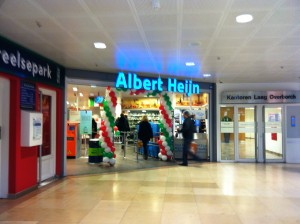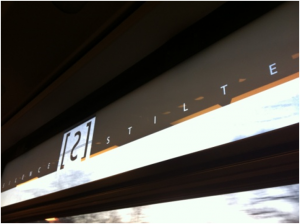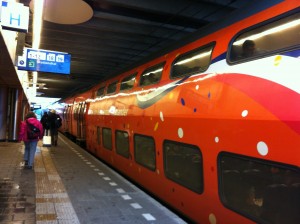Indispensible – treinen! Posted by Sten on Mar 23, 2014 in Culture, Dutch Vocabulary
I think it is time for me to clear some things up about traveling in Dutch treinen (trains, singular trein). In everyday speech, the Dutch also introduced the verb treinen (literally ‘training’) to describe traveling by train. So just the word treinen can mean trains or ‘training’/traveling by train.
To describe how treinen usually goes, I will write a little story about it.
Right now I trein. I just came from Maastricht and just went through Utrecht Centraal (short for Utrecht Centraal Station – Utrecht Central Station). I had to switch treinen, called overstappen. At Utrecht Centraal, I went to the Albert Heijn (big supermarket chain in the Netherlands) to get some avondeten (dinner).
Then I headed back to the stationshal (station area) and looked for my spoor (platform). I had to go to spoor 11. When my trein arrived, I walked to one of the deuren (doors) and stood aside to let all reizigers (travelers) leaving the trein go first – the first habit of the Dutch. When I entered the trein, I found a place in a stilte-coupé (silent compartment – where people should be silent, so others can work). A man (man) came after me and took the seat next to me. Here, people barely ever ask you if they can sit next to you – just out of beleefdheid (courtesy) – and just sit down. Also, even when you are not in a stilte-coupé, but in a normal coupé, people barely start a gesprek (conversation) with a reiziger they do not know. I have noticed that in other countries, such as Germany, this happens more. How is that in your culture?
Some facts about Dutch treinen (those most prevailing in the country, of the Nederlandse Spoorwegen (NS) (The Dutch Railways) you should know:
– All NS treinen are yellow – except for some special editions. One was for example when koningin (queen) Beatrix resigned and her son Willem-Alexander succeeded her;
– Most treinen use electricity – there are only a few left that use diesel to move forward;
– There are Intercity’s (Intercity trains – the quick ones) and stoptreinen (local trains – the slow ones that stop at everywhere). The NS version of stoptreinen is called Sprinter, and colloquially often used too;
– You can take your fiets (bike) with you if you like against an extra charge of 6 euro;
– There is tweede klas (second class) and eerste klas (first class). The differences are that in the eerste klas the seats are nicer, the coupés less crowded (because less reizigers are paying for eerste klas) and in some treinen power outlets are provided;
– Generally, all treinen have free Wi-Fi;
– opposed to treinen in other countries, in the Netherlands treinen generally don’t wait at one station very long – so when you have to get off, get ready in time;
– Some trains are dubbeldekkers (double decker – with two floors). When you have a lot of baggage (luggage), do not sit boven (upstairs), because there is quite limited space for baggage there;
– When it gets very, very druk (crowded), it is accepted that you sit in the eerste klas;
– It normally is very druk during the spitsuren (peak hours), which are between 6:30-9:00 AM and 16:30-18:00 PM. The hours in between are called daluren (off-peak hours);
– Various winkels (stores) sometimes have aanbiedingen (special offers) for treinen, including Hema, Kruidvat, and Albert Heijn. For example, you can trein unlimited anywhere in the Netherlands for one day for 14 euro;
– when you want to plan your reis (trip), you can best use www.9292ov.nl or www.ns.nl. Both also have an application for smart phones;
– during weekends there are often werkzaamheden (construction works) on the rails (tracks), because in weekends it is the least druk. So it can happen that there is a bus instead of a trein taking you to your destination – no extra charge of course;
– other railway companies are Veolia, especially in the south; Arriva, especially in the north of the country; Connexxion and Syntus mainly in the east; and Breng mainly in the west. These companies only use stoptreinen.
– Most NS treinen, and all Intercity´s have WCs (restrooms) – of course not as neat as you have at home, but hey, they work! – The Tweede Kamer (the Dutch House of Representatives) decided that from 2025 all treinen in the Netherlands must have WCs.
I have noticed that in comparison, Dutch travel differently. Someone once told me this is due to the huge population that inhabits this small area on the surface of this earth. That they get in touch with so many people every day, and therefore don’t feel like talking with others so much. Or that they have so much work to do that they just lack the time to talk…
How do people trein, or travel in your culture? Any similarities or differences?
Dubbeldekker picture: © Omroep Zeeland

Build vocabulary, practice pronunciation, and more with Transparent Language Online. Available anytime, anywhere, on any device.
About the Author: Sten
Hi! I am Sten, both Dutch and German. For many years, I've written for the German and the Dutch blogs with a passion for everything related to language and culture. It's fascinating to reflect on my own culture, and in the process allow our readers to learn more about it! Besides blogging, I am a German-Dutch-English translator, animator and filmmaker.







Comments:
Grethe:
In Norway, we have both similarities and differences to the Dutch travel. First, a difference: we generally prefer to have more space, so in a bus or train with 10 people and 20 seats, they will usually take up a double seat each, rather than sitting next to each other. Often people leave a handbag or backpack on the seat next to them, as if to prevent people from sitting down, unless absolutely necessary. If the bus is getting full, the new passengers may have to ask if the seat is available, but then the reason for asking is to get the other person to move their stuff.
We’re like the Dutch in the sense that we don’t usually start a conversation with strangers. Not on the bus, not in a pub. If you try talking to a Norwegian stranger, they will most likely feel awkward (unless you ask for directions or the time, then it might be ok).
Norwegian trains are relatively cheap, especially when travelling long distances. Norway still has a state owned train service, and public transport is subsidised. If you book in advance (nsb.no), you can get long distance tickets for as little as 250kr (€30) one way.
Lastly, back to the Dutch trains – the stoptreinen are now called sprinters (not very logic). It was quite confusing when we first came to visit after they made that change.
Sten:
@Grethe Hi Grethe!
Thank you for your contribution!
Oh yes, people do tend to take double seats here as well. And the handbag procedure to get them to move their stuff also sounds very familiar.
And all the other things you say… Dutch treinen and the system seem to be very similar.
Only the NS stoptreinen are called Sprinters. I guess what they mean with a Sprinter is a train that speeds up quickly, runs a short distance in a very short time, and then stops, and repeats. So it sprints between stations!
Peter Simon:
Hi, Sten, a few remarks.
I’d like to point out that most non-intercity trainen are not run by NS, but by local companies like Arriva, Syntus, Veollia or Connexxion, and besides ‘stoptreinen’, there are some called ‘sprinters’ as well (quite similar in essence). On most, if not all of those slow treinen there is no toilet, probably because they make relatively short journeys (but not always).
As to my background info about other countries, if you travelled by train anywhere in Hungary, you’d just be glad to have so nice toilets as in the Netherlands. There is mostly only filth. People there almost never say a word to each other and rarely ask if they could sit beside you, so to my mind, the Dutch do talk a lot to each other.
In Britain, I only have experience about travelling by bus, and people seemed to be very friendly to each other there. I travelled quite extensively on trains in China, where everybody talks to everybody else sometimes. And do not tell me the density of the population in the Netherlands is higher than in most parts of South-East China, especially on trains: on some services, people sit on each other and one can hardly move a bit. What else is there to do, then, than talk? 🙂
Sten:
@Peter Simon Hi Peter!
Thank you for the remarks and the words about what you have experienced. Very interesting!
After what Grethe wrote, I think the population density argument fails as well, and like you say, it does not make much sense either when it is the other way around! Unfortunately, it is not a solution to the silence between Dutch reizigers.
In the Netherlands, reizigers are very talkative whenever they travel with friends, or just see people they know. My point concerns strangers – talking between strangers just does not happen much. I did it myself yesterday actually! Trying to get that awkwardness away ;-).
I have heard that of British trains! I myself have had great, great conversations in Germany. I have never been to China, but I will keep that in mind!
I have corrected and further researched what you said. The sprinters are the NS stoptreinen. You were right with the toilets, but from 2025 they are mandatory on trains.
Nikki:
Just a minor thing – spoor is “track”, the thing the train is on. The platform is perron. Not a big deal, just don’t tell a Dutch person you’re waiting “op spoor 11” – they’ll laugh at you 🙂
mads:
@ Nikki, spoor is platform in Holland, whichever the translation. 🙂